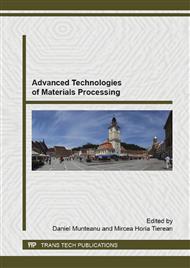p.217
p.224
p.230
p.236
p.242
p.254
p.261
p.271
p.282
Research on GTAW/SMAW Weldability of ADI/DI Using Electrodes ENi-Cl and ENiFe-Cl-A
Abstract:
The present research is dedicated to weldability of Austempered Ductile Iron (ADI) and Ductile Iron (DI) using Shielded Metal Arc Welding (SMAW) and Gas Tungsten Arc Welding (GTAW) methods. The welds were done using the arc welding process with Nickel base filler materials: ENi-Cl and ENiFe-Cl-A. Each weldment was examined visually, with X-rays and mechanical tests. After the mechanical tests, tensile test and impact properties of the welded joint are lower than mechanical properties of the ADI base material using ENiFe-Cl-A filler metal and GTAW process. This type of filler metal ENiFe-Cl-A can be applied successfully only for repair by welding of ADI parts. Using ENi-Cl filler metal with GTAW process applied to DI, the mechanical tests, tensile test and hardness of the welded joint are greater than mechanical properties of the DI base material. This procedure can be applied for welding. In case on DI welded using SMAW with ENi-Cl electrodes, the hardness of the welded joint is lower than the hardness of base material. This procedure can be applied only for repair by welding.
Info:
Periodical:
Pages:
242-253
Citation:
Online since:
October 2015
Authors:
Keywords:
Price:
Сopyright:
© 2015 Trans Tech Publications Ltd. All Rights Reserved
Share:
Citation:


